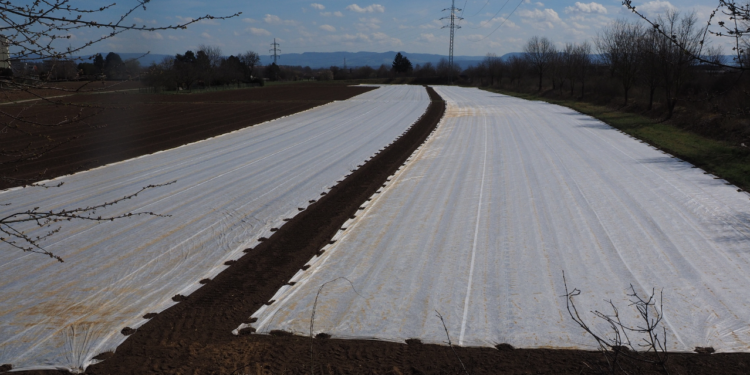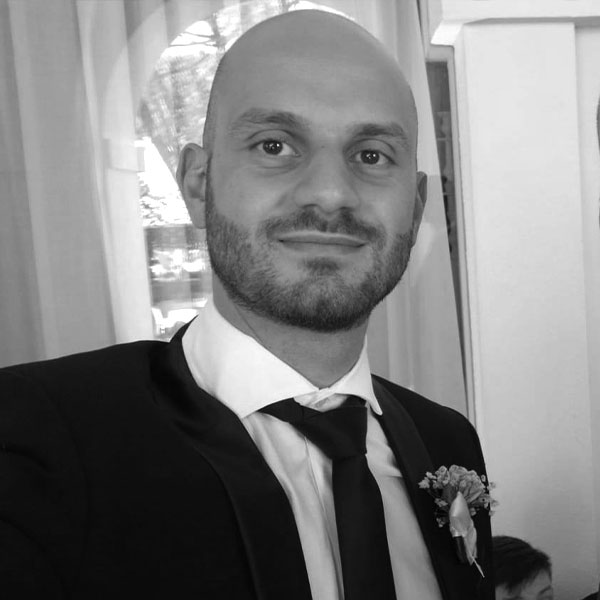The new woven uses biocompatible materials and combines the characteristic of biodegradability with the ability to fertilize the soil after its dissolution
Protective sheets are widely used in agriculture to protect the most delicate crops. The most commonly used materials are plastic and therefore involve problems related to biocompatibility and disposal. A new non-woven material was presented during the E-nnovate 2020 event. The material is obtained by needle punching method and consists of wool and chicken feathers. The new non-woven has a high water capacity, adheres well to the soil and is intended to cover a variety of surfaces, from weedy soils to new landfills, railway embankments, ski slopes, etc. In addition, the material degrades by 70% after 2-3 months. As a result of degradation, the nitrogen released from wool and feathers enriches the soil with nutrients, replacing fertilizers.
The material is the product of research carried out at the ŁUKASIEWICZ Research Network – Institute of Biopolymers and Chemical Fibers, Lodz and the Univeristy of Agriculture, Krakow, both in Poland. We interviewed the inventors Krystyna Wrześniewska-Tosik, Tomasz Mik, Ewa Wesołowska, Tomasz Kowalewski, Damian Walisiak, Michalina Pałczyńska, Dariusz Dębiec, Piotr Kacorzyk.
The creative process is always a fascinating aspect. Tell us a little bit about why you thought about this invention and what the objectives are.
“Nowadays, environmental problems are of particular importance. Legislative policy is forcing industry to seek and use renewable resources that can replace conventional petroleum products. Recently, researchers and industries try to find new ways to use bio-waste in order to develop renewable and sustainable products with added value. When considering the most globally abundant, unique and inexpensive waste streams which could be utilized for value added applications, the poultry industry cannot be overlooked. The waste stream in poultry industry consists of feathers, internal organs, blood, bones, skin, feet and residual meat. From these coproducts, especially, poultry feathers have attracted interest”.
“The main objective of the project is to create a concept of waste management methods and by-products from animal production, desirable from the point of view of economics and social effects. The project includes elaboration and creation the guidelines for the implementation of production the ecological, protective nonwovens with the addition of feathers for covering the grassy-bean mixture on difficult terrains ( ski slopes, railway embankments, new dumps, heaps) where getting a good sodding is very difficult. During the formation of these surfaces, large amounts of soil are shifting, extracting on the surface the mother rock, poor in nutrients and biological life, which are necessary for plant development. Precipitation, especially intense, rinsing out seeds, soil and moves them to the lower parts of area”.
“In addition, the low soil water capacity , the large slope of terrain causes rapid drying of the top soil layer. This is particularly disadvantageous in the first stage of plant development, because the root system is underdeveloped and cannot use water and nutrients located in the deeper layers of the soil, so often on hot days the plant seedlings are lost. The solution to the above problems is application of a protective non-woven. The nonwoven fabric characterizes the following useful properties: light color, surface mass approx. 150-300 g / m2, good adhesive properties, large water capacity, appropriate structure”.
“Such non-woven protects the seeds and soil from washing off, limits the impact force of rain drops on soil aggregates, inhibits rain water runoff. On stony soils, most often on the slopes we are not able to cover all sown seeds with soil. Heavy nonwoven fabric, presses the seeds to the soil, covers them and improves the conditions for germination and seedling development. The properties of the nonwoven for rainwater retention and water resulting from dew formed during the night, and then its slow evaporation during the day due to the light color of the nonwoven – high albedo, is very important for young plants. The microclimate created under the cover with increased humidity causes a decrease of the temperature amplitude between day and night compared to uncovered surfaces”.
“The nonwoven fabric decreases the loss of ammonium nitrogen escaping from the soil to the atmosphere, it is a source of fertilizer components during its biodegradation. The application of biodegradable nonwoven will enable its quick and cheap disposal at the place of usage and this is the smallest environmental burden in the all product life cycle, which is a measurable economic and ecological effect. Realization of the Project’s objective will contribute to a great extent to the management of hardly biodegradable waste in the form of feathers and a new assortment will appear on the target market for non-woven fabrics”.
How does your invention improve existing technologies?
“Currently, there are various types of nonwovens based on petroleum-derived raw materials available on the market and they are non-biodegradable. So far, no nonwoven fabric has been developed using waste poultry feathers. The innovative protective nonwovens with the addition of waste feathers developed in the project are made of raw materials of natural origin. An additional advantage is the ability to control the time of microbiological decomposition by the proportion of feather fractions in the produced nonwoven fabric. The higher the feathers additive, the longer the biodegradation time will be. Protective nonwovens contain only components of natural origin. Due to the content of organic matter in their composition, they will be a valuable source of fertilizing ingredients for plants and soil microorganisms. The proposed solution is friendly to the environment and human health, at the same time ensuring the reduction of biomass waste in the form of feathers, deposited and polluting the environment”.
Has the idea already been patented or do you plan to patent it?
“Patent application No. P.430284 has been prepared and submitted. In the future, we hope that our nonwovens will be covered by full patent protection”.
What will be the next step? How do you plan to improve your invention or its diffusion?
“We plan to implement our solution it by a Polish industrial partner but we do not exclude entering the foreign market if there is a proposal from entrepreneurs. Innovative nonwovens will be offered to entities dealing with the protection of embankments, ski routes, flood embankments, as well as companies that care for the maintenance of urban greenery. The recipients will include Melioration Plants due to the fact that in Poland over 70% of flood embankments require renovation. We plan to disseminate our product at various types of innovation fairs, exhibitions, in social media, leaflets promoting the product will be prepared”.
Research carried out as part of the “EKOPIÓRO” Project co-financed by the EU from the European Regional Development Fund No. POIR.04.01.04-00-0059 / 17
Project Consortium: Ł-IBWCh-Łódź, UR- Kraków, CEDROB- Niepołomice, Poltops- Żagań.

































